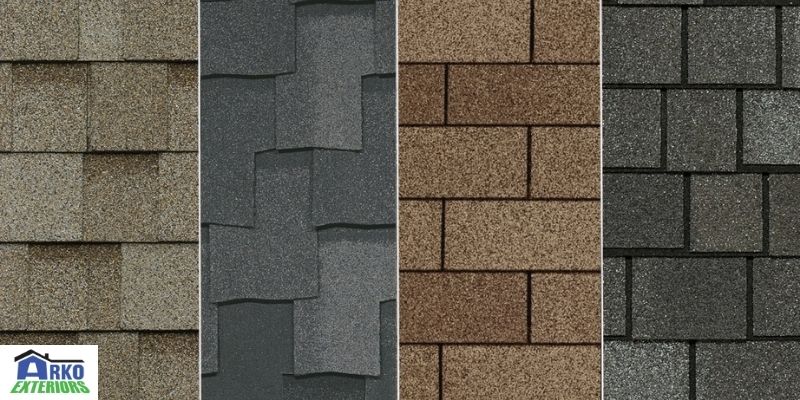Asphalt shingles are a popular residential roofing material. These shingles are available in various textures, colors, profiles, and styles to suit all kinds of roofs and home styles. The design of asphalt shingles can give them the look of wood, cedar, and/or slate roofing. They are sustainable, durable, and cost-effective. These shingles may also be recycled or used in paving.
Types Of Asphalt Shingles

With the various options of asphalt shingles available, homeowners can give their homes a unique look without having to spend much money. There are organic asphalt shingles which are waterproof. For UV ray protection, ceramic granules can be applied along with a thin layer of asphalt as an adhesive. However, they no longer manufacture organic shingles these days because they are not eco-friendly. Then there are fiberglass asphalt shingles which are made with a combination of ceramic granule(s), asphalt coating on top, and woven fiberglass beneath. These materials help in creating UV-protectant and waterproof shingles. As a result of the low amounts of asphalt in the combination, the shingle is extremely thin and lightweight!
Key Features Of Asphalt Shingle Roofs

Asphalt is not the only material used in making asphalt shingles. Depending on the manufacturer, shingle components vary. Many of them contain cement fillers and mineral fiber. However, the asphalt content in most shingles falls between 5 to 35 percent.
Generally, these are the key features that the asphalt shingle roof should have:
1. Underlayment
Underlayment is a water-resistant material. It is installed directly onto the roof, and it protects the roofing system against harsh weather. The main purpose of the underlayment is to prevent water and wind infiltration. It also acts as a seal on your roof. The underlayment is one of the most important roof layers, even though it is not visible.
There are three main types of underlayment — non-bitumen synthetic asphalt, rubberized asphalt, and asphalt-saturated felt. Non-bitumen synthetic is well known for being durable and lightweight. It is made from either polyethylene or polypropylene fibers. It is highly moisture-resistant and is widely used due to its resistance and strength against pests and other elements. Rubberized asphalt is used for all types of applications. This rubber-like material is hard and resilient. It is a type of underlayment that is self-adhering, creating a tight seal for preventing water infiltration in the deck. Asphalt-saturated felt is made from organic fiberglass materials. Although this underlayment is water-resistant, it is not entirely waterproof.
2. Ice And Water Barrier
Your roof needs to be protected from damage caused by wind-driven rain and ice dams by the ice and water barrier. This barrier is a waterproof underlayment membrane. It is designed for protecting the parts of your roof most vulnerable to water and ice damage.
The back surface of this material is made with modified bitumen adhesive. The top surface of this membrane is slip-resistant, giving roofers proper traction during the installation process. Leaks that happen as a result of severe weather can be prevented when your entire roof is covered with an ice and water barrier membrane.
Make sure that your attic has sufficient ventilation before using this membrane to cover your roof completely.
3. Starter Strip
The starter strip is an important component of your new roof. It is used during a roof replacement to waterproof the rake and eave edges of your home. Starter strips have different colors, but it doesn’t matter as asphalt roof shingles are laid over them. Typically, starter strips are produced in rectangular shingle shapes. Their shape makes them compatible with different styles of overlying shingles. Additionally, the material that is used in making many fiberglass reinforced asphalt shingles is also used in making starter strips. The joints between the finishing shingles are also covered by starter shingles at the eaves. This ensures that the roof protection is completely water-resistant.
The function of starter strips differs when installed at the edges of the rake. At the rake, it helps with the roof’s resistance to wind. Additionally, it gives a straight line to the roofer. This line can guide your roofer when ending every layer of the field shingles.
4. Ventilation System
The ventilation system of your roof ensures the continuous flow of air to attic spaces, allowing moist and warm air to escape from the attic. To encourage the proper circulation of air, vents of various types can be installed in different areas of your roof.
Furthermore, it is important to your roofing system that the ventilation is designed and constructed correctly. In the design, there should be enough space beneath the eaves and roof that allows for airflow and insulation.
A system that is well designed will ensure a good balance between ventilation and intake beneath the roof. This also helps in reducing energy bills as the air-conditioned air will not be able to quickly escape through the vents.
5. Hip And Ridge
The hip and ridge shingle is a feature that gives your new roof the finishing touch it needs. For weather-tight protection, experienced roofers ensure that these are installed at the system’s peak to bridge any two roof slopes. Also, for some roofing shingles to function properly, special hip and ridge shingles are needed. Hip and ridge shingles are available in a wide range of thicknesses or profiles. This variety can give your roof a more appealing visual appearance.
Conclusion
Now you know more about the types of asphalt shingles and the key features of asphalt shingle roofs. To avoid premature roof failure and costly repairs, make sure you (and/or your roofer) consider these features when installing a new asphalt shingle roof.

